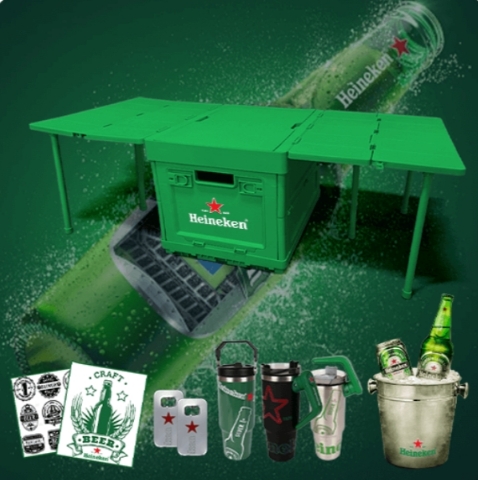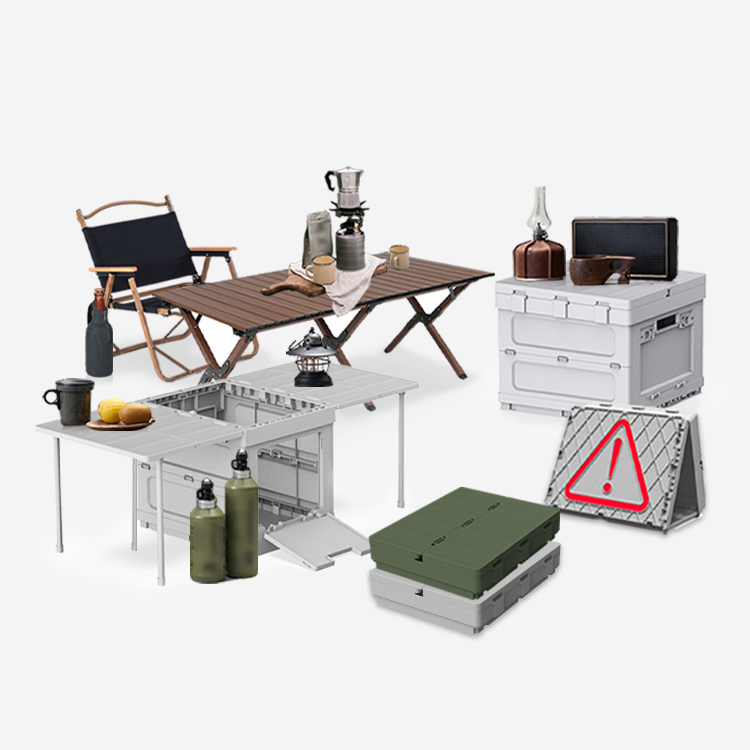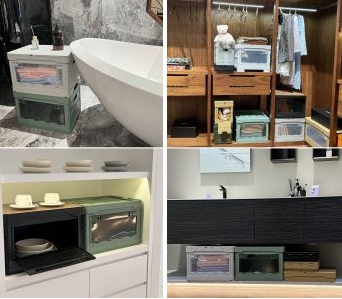Introduction
Promotional gifts for customers are a proven method to build loyalty and enhance brand recognition.Promotional products for clients have been a long-established marketing strategy used by companies worldwide to boost goodwill and raise brand recognition. In an era of overwhelming digital marketing, a tangible present beverage promotion gift—Folding storage box,such as a branded pen, customized apparel, or high-tech device—can leave a memorable impression that online advertisements often do not successfully accomplish. Indeed, the worldwide market for promotional products is vast, estimated at around $86 billion in 2022 (32+ Promotional Product Statistics You Must-Know in 2024), highlighting the significance and influence of this practice. Consumers truly value these free items: a sector study revealed that 99% of individuals are ready to make an effort to get a promotional product (Promotional Products Statistics In 2025 – SellersCommerce). Due to their widespread appeal and demonstrated success, international corporate purchasers and brand proprietors persist in allocating resources to promotional items as an essential component of customer interaction and brand development tactics. This guide examines the reasons promotional gifts are effective, how to use them properly (featuring logos and branding), and what to keep in mind when procuring wholesale promotional gifts from key supply centers such as China and Dubai.
Why Promotional Gifts Work: Impact on Brand and Customers
Promotional gifts have earned a reputation as a highly effective marketing tool backed by data and real-world results. Numerous studies and case analyses demonstrate their powerful impact on consumer behavior and brand perception:
High Brand Recall and Favorability: Recipients of promotional gifts remember brands at impressively high rates. Roughly 9 out of 10 people recall the brand name after receiving a promotional product (Promotional Products Statistics In 2025 – SellersCommerce). This far exceeds recall rates for traditional ads. Promotional items not only stick in memory, but they also create positive feelings: consumers are nearly 2.5 times more likely to view promotional products favorably than internet ads (32+ Promotional Product Statistics You Must-Know in 2024). In other words, a useful branded item (like a mug or USB drive) can leave a more lasting and positive impression than a fleeting banner ad.
Increased Customer Willingness to Do Business: Promotional gifts for customers can directly influence purchase decisions and loyalty. 73% of people are more likely to do business with a brand that provided them a promotional gift (Promotional Products Statistics In 2025 – SellersCommerce). This means that giving a valued item—such as a custom tote bag or a branded notebook—can nudge a potential client toward choosing your products or services over a competitor’s. For existing customers, the gesture of a gift strengthens loyalty: one survey found 83% of consumers are more loyal to a brand that gives them a promotional product (compared to brands that don’t) (Promotional Products Statistics In 2025 – SellersCommerce). Essentially, a thoughtful gift can translate into repeat business and long-term customer relationships.
Tangible Engagement and Lead Generation: Unlike many forms of advertising, promotional merchandise physically engages the audience. This can drive behaviors such as visiting a store or booth or sharing contact information. For example, a case study in the trade show industry showed how a company’s attractive giveaway helped create booth traffic and resulted in collecting hundreds of new leads (Promotional Products Case Studies Archives – Warwick Publishing). The gift (in that case, a branded pouch with freebies) not only attracted visitors but also made the brand memorable to attendees. This real-world example highlights how promotional gifts for customers and prospects can actively spur engagement and provide measurable returns (like lead counts or sign-ups) in ways that passive ads cannot.
Longevity of Brand Exposure: A well-chosen promotional gift can keep your brand in front of customers for months or even years. Studies indicate that 87% of consumers keep a promotional product for more than a year , and many keep them over 10 years if the item remains useful. This longevity means a single gift (for example, a quality coffee mug on someone’s desk or a logo T-shirt in their wardrobe) will generate repeated brand exposures without additional cost. In marketing terms, the cost per impression becomes incredibly low over the item’s lifespan. One extensive industry analysis found that promotional products deliver impressions at a cost as low as $0.001 (one-tenth of a cent) per impression (ASI’s 2022 Ad Impressions Study Definitively Proves Promo’s Influence Nationwide • ASI) – far cheaper than the cost per impression for TV, print, or online ads. This makes promotional gifts one of the most cost-effective advertising mediums available.
Case Study – Strengthening Customer Relationships: Promotional gifts can also enhance customer satisfaction and retention. For instance, a local bank looking to thank new clients used branded tri-fold calendars as a promotional gift. The result was improved customer relationships and longer account retention, with the bank’s name visible on the customer’s desk 365 days a year via the calendar . This case underlines how a simple branded gift given at the right moment (in this case, account sign-up) can add value for the customer and serve the company’s interest by keeping the brand top-of-mind daily. Such gifts act as constant reminders of the business, reinforcing trust and loyalty over time.
In conclusion, promotional gifts are effective as they establish a mutually beneficial situation: customers or potential clients feel valued and gain something beneficial, while brands experience increased visibility, positive sentiment, and frequently a direct rise in sales or inquiries. The evidence – from statistical research to on-the-ground case studies – firmly establishes promotional gifts for customers as a marketing approach with high effectiveness in building brand equity and driving consumer action.
Maximizing Impact with Promotional Gifts with Logos
To reap the complete advantages of promotional gifting, it is essential to focus on the nature of the gift and how it embodies your brand. This is where branding and design play a role – particularly in producing promotional items featuring logos and messages that resonate with your brand identity and attract your intended audience. Here are essential factors to consider when creating impactful promotional gifts:



Relevance and Usefulness: Select gift items that are relevant to your customers’ interests or your industry, and ensure they are genuinely useful. An item that integrates into the customer’s daily life (like a high-quality water bottle, tech accessory, or tote bag) will likely be kept and used frequently, maximizing exposure for your logo. According to industry research, practical items are kept longest – for example, logoed drinkware, bags, and apparel tend to be retained by consumers and used regularly, leading to countless impressions of your logo over time (Promotional Products Statistics In 2025 – SellersCommerce). Always ask: Will this item provide value to the customer? A well-chosen gift reflects that your brand understands and cares about the customer’s needs or lifestyle.
Quality and Durability: Quality is paramount for both the item and the logo imprint. A promotional gift is a direct reflection of your company’s standards; a flimsy product or a logo that easily fades can hurt your brand’s credibility. Choose items made of durable materials and work with suppliers who use reliable printing or engraving techniques so that your company logo remains sharp and resilient through regular use. The goal is for your branded gift to still look good and function well months or years later. This longevity not only extends your brand exposure (as noted, many customers keep good-quality promotional gifts for a year or more) but also sends a message that your brand delivers quality. For instance, consider a logo-branded USB drive that continues to work properly, or a jacket with an embroidered logo that withstands many washes – such items will leave a far better impression than cheap trinkets that break immediately.
Branding and Aesthetics: When creating promotional gifts with logos, ensure the design is consistent with your brand’s visual identity and values. Use your correct brand colors, logos, and slogans in a tasteful way. The branding should be visible yet elegant – overly aggressive branding might deter users from wearing or using the item, whereas subtle but clear branding can make the item feel like a gift rather than just an advertisement. Many successful corporate gifts integrate the company logo alongside a stylish design or useful message. For example, a notebook might have a small embossed logo on the cover and a motivational quote on each page, aligning with a brand that promotes inspiration. The best promotional items blend marketing with aesthetics: they are something customers feel proud to use or wear, which in turn increases the visibility of your logo to others. This effect can amplify reach; for instance, a well-designed folding storage box with your logo effectively becomes a functional display of your brand that customers frequently interact with.



Alignment with Brand Values (e.g. Sustainability): Today’s global consumers are often attentive to a brand’s values. If your company emphasizes sustainability or social responsibility, consider reflecting that in your promotional gifts. Eco-friendly promotional gifts (such as reusable shopping bags, bamboo fiber drinkware, or solar-powered gadgets) not only appeal to environmentally conscious customers but also enhance your brand’s credibility on those issues. A survey found that 46% of consumers have a more favorable opinion of an advertiser if the promotional product received is environmentally friendly (32+ Promotional Product Statistics You Must-Know in 2024). Thus, matching your gift to your brand ethos can deepen the impact. Likewise, if innovation is a core value, a tech gadget or a creative new product as a gift will reinforce that message. The key is consistency: the promotional item, the way it’s presented, and the embedded brand message should all convey a coherent story about your company.
By carefully planning the choice and design of promotional gifts for customers, companies can ensure these gifts do more than just carry a logo – they deliver an experience and message that resonates. A well-executed promotional gift (with the right item, quality, and branding) not only delights the recipient but also strengthens the overall brand image each time the item is seen or used.
Sourcing Wholesale Promotional Gifts: Key Factors and Supplier Insights
Implementing a promotional gift campaign often requires sourcing large quantities of items customized with your logo. This makes wholesale promotional gifts procurement a crucial step. Global corporate buyers typically look to established supply markets to fulfill their needs cost-effectively and reliably. Two core supply regions stand out in this industry: China and México.
Major Supply Hubs:
China – The World’s Promotional Products Factory: China is the undisputed leader in manufacturing promotional gifts at scale. The country’s vast network of manufacturers (especially in regions like Guangdong, Zhejiang, and Fujian) offers an enormous variety of products – from simple keychains and pens to high-end electronics – at highly competitive prices. Chinese suppliers are adept at customization, allowing buyers to order promotional gifts with logos, tailored colors, and custom packaging. Thanks to economies of scale, buyers can source large bulk orders from China very cost-effectively, which is ideal when aiming for tens of thousands of units. Many Chinese manufacturers and trading companies specialize in serving corporate clients internationally, and they are experienced in meeting branding requirements, quality standards, and tight deadlines. Global brands often attend trade fairs such as the Canton Fair or work via online B2B platforms to find reliable Chinese partners for wholesale promotional gifts.
México – Un Mercado en Crecimiento para Regalos Promocionales:
Mexico has evolved into a more important market for promotional products, presenting considerable chances for brands aiming to improve their visibility and consumer involvement. Mexican consumers exhibit a distinct inclination towards promotional gifts, placing them higher than conventional advertising methods like radio, newspapers, magazines, and online advertisements.
Essential findings reveal that promotional items highlighting “Made in Mexico,” eco-friendly practices, or social responsibility significantly connect with consumers. In particular, 59% of consumers in Mexico have a more positive opinion of advertisers who offer locally made gifts, while 75% favor eco-friendly products, and 54% react favorably to socially responsible offerings.
The leading promotional items in the Mexican market are drinkware, USB drives, and desk accessories, all esteemed for their functionality and everyday utility, successfully guaranteeing ongoing brand exposure. Businesses seeking to grow their market presence in Mexico can utilize these insights, choosing promotional items that closely match local consumer tastes and cultural values. Mexico’s advantageous position and engagement in regional trade shows enhance links with local and global promotional gift suppliers, ensuring effective sourcing and customization that align with regional preferences and market trends.
When choosing suppliers for wholesale orders, regardless of region, corporate buyers should keep several key factors in mind:
Product Quality and Compliance: Ensure the supplier can meet the quality standards your brand requires. Request samples to examine the build, materials, and logo print quality before placing a full order. For electronics or items with safety considerations (e.g. toys, food-related items), verify that the products comply with relevant international safety certifications. Reputable suppliers should readily provide testing reports or certifications for materials and paints (for example, compliance with EU or US safety standards). Quality control is critical: a trustworthy supplier will have robust QA processes to catch defects before shipping.
Customization Capabilities: Assess the supplier’s ability to produce the customization you need – whether it’s a complex full-color logo print, engraving, embossing, or unique personalization for each unit. Not all suppliers excel in all types of logo application, so choose one whose facilities and expertise match your project (for instance, textile embroidery vs. plastic molding vs. electronic printing). Ask for portfolios or client examples of similar promotional gifts with logos that they have produced. This will give you confidence that your branding will be executed correctly and consistently on all items.
Minimum Order Quantities and Pricing: Wholesale promotional gifts suppliers usually have a minimum order quantity (MOQ) for custom orders. Ensure that the MOQ aligns with your campaign scale. Negotiate pricing based on volume – larger orders typically yield significantly lower unit costs. It’s wise to get quotes from multiple suppliers to benchmark costs. However, be cautious of prices that seem unrealistically low, as they might indicate compromises in quality. Aim for a balance of cost-effectiveness and quality rather than simply the cheapest option.
For example, when sourcing folding storage boxes as promotional gifts, the MOQ might be as low as 50 units. This allows businesses with smaller campaigns to benefit from wholesale pricing without the need for an extremely high order volume. However, it’s still important to verify the quality of the folding storage boxes and ensure that the supplier can consistently meet your branding specifications.
Lead Time and Logistics: Consider the production and shipping timelines. If you are ordering from China or another distant manufacturing base, factor in production lead time (often several weeks depending on order size and complexity) plus shipping time (which can range from fast air freight to slower sea freight). Suppliers should provide a clear schedule from order confirmation to delivery. If you have a firm event date (for example, an exhibition or holiday campaign), build in some buffer in case of delays in production or customs. Dubai-based suppliers might offer faster regional delivery, but still clarify their stock availability versus time needed for logo branding. Reliable suppliers will communicate proactively and provide tracking for shipments.
Supplier Reputation and Communication: Finally, evaluate the supplier’s track record. Look for established companies with positive testimonials or references from other corporate clients. Good communication is essential – the supplier should be responsive, transparent, and able to understand your requirements (language proficiency in English is important for international dealings). Miscommunication on specifications can lead to costly errors. Many buyers start with a smaller trial order to test a new supplier’s service and quality before committing to a large wholesale order. Additionally, consider suppliers who offer contracts or guarantees – for example, agreements on reprinting or refunds if the delivered goods do not meet the agreed specifications. This adds a layer of trust and protection to the transaction, which is important when dealing with overseas providers.
When collaborating with Chinese suppliers, ensuring product quality and compliance is crucial. Businesses should first clarify their requirements by defining product types, quality standards, and budget through in-depth internal analysis to understand specifications such as materials, dimensions, functionality, and performance. It is also essential to assess supplier reputation by evaluating their history, financial stability, and adherence to industry standards. While price is an important factor, companies should not prioritize cost over quality, as comprehensive due diligence and strategic use of technology can help balance these aspects. Additionally, supplier responsiveness and service level play a key role—choosing a supplier who can quickly address issues and provide reliable support ensures smooth operations. By focusing on these factors, businesses can confidently source wholesale promotional gifts that meet expectations—high-quality, accurately branded, and ready to impress customers.
Conclusion
Promotional gifts for customers remain a powerful marketing tool in today’s business landscape, combining tangible customer value with effective brand promotion. When executed thoughtfully, a promotional gifting campaign can yield significant benefits: enhanced brand recall, stronger customer loyalty, new client acquisition, and an impressive return on investment through sustained impressions. Achieving success in this arena requires a strategic approach in both designing the gifts and sourcing them at wholesale. Brands must choose their promotional items carefully, aligning them with the interests of their audience and the identity of the company, and ensure each item proudly and durably carries the company logo. Equally important is selecting reliable supply partners who can deliver quality merchandise at scale. By adhering to these best practices and grounding decisions in data and proven examples, companies can leverage promotional gifts not just as trivial freebies, but as integral components of an authoritative, trust-building marketing strategy. In a world of intense competition for customer attention, a well-placed gift with a logo can truly set a brand apart – creating a positive experience that keeps customers remembering and returning to the business .

























